Site menu:

May 2008 Newsletter
Gronant Little Tern Colony.
April Bird News.
Forthcoming Events.
Latest Newsletter.
In some ways it was a frustrating season at Gronant in 2007. Given the third ever highest number of breeding pairs and a very low rate of predation we would have expected a near record number of fledged birds, but unfortunately the weather intervened! Nevertheless, taking into consideration the appalling weather the season turned out remarkably well.
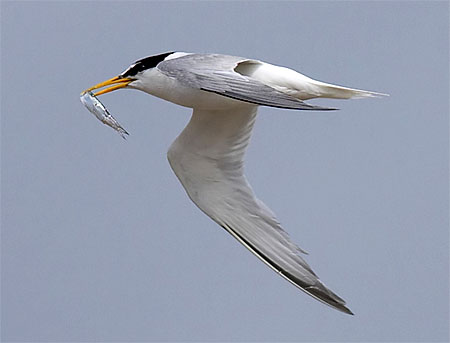
It was a good spring with many migrants arriving back early, including the Little Terns - the first ones were seen back at Gronant with six on April 22nd. Numbers didn't increase significantly until May 14th when there was 14, nesting began on May 21st and the first eggs observed on 25th.
Predation
Historically the main predator at Gronant have been Foxes, but the
purchase of a much more effective electric fence a few years ago has meant that this
problem has been eradicated. In 2007 a fox actually jumped over one of the
fences, but as was apparent from its tracks it seems to have got an electric
shock and panicked, eventually digging under the fence and leaving the nests
untouched.
As soon as the first eggs are laid in late May the Crows try to eat them.
This is where wardening is vital to chase them off. It was estimated a total of
12 eggs were taken in 2007, most in late May. This early in the season this is
not a big problem as eggs will be re-laid. As we go into June crow attacks
usually tail off despite the fact that the majority of terns lay eggs in this
period. But because of this increase in nesting activity the Little Terns become
more aggressive and this, with the wardens' help, deters the crows.
A determined Kestrel or two can virtually decimate a Little Tern colony.
In 2001, one male Kestrel, together with the foxes, succeeded in taking all but
one of the chicks that year. 2006 was also a problem year with, very unusually,
11 adults taken together with 12 chicks. Again wardening is vital, although a
Kestrel is far more difficult to stop than a crow! In contrast to 2006 we had a
kestrel free year in 2007, they were certainly about in the sand dunes inland
but there was no recorded predation of the colony - presumably because of a
bumper vole year.
Breeding Success
Little Tern colonies are notoriously variable with their breeding success, both in terms of breeding pairs and the resulting number of fledged young. For example as you can see from the graph below in 2001 only one chick fledged at Gronant, in 2002 only 57 pairs nested, yet in 2003 we had 110 pairs producing 190 fledged birds!
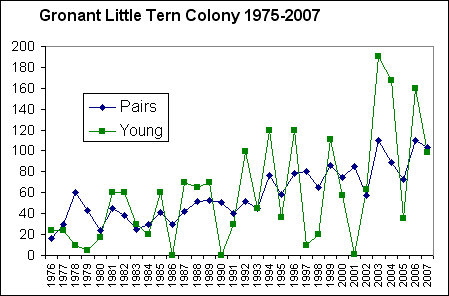
Despite the variation shown in the graph above the numbers at
the Little Tern colony at Gronant are relatively stable compared with some colonies
elsewhere in
the country. For example at Great Yarmouth only 17 pairs bred
in 2004, producing no fledged young. Yet in 2006 a remarkable 673 fledglings
were produced from 276 nests!
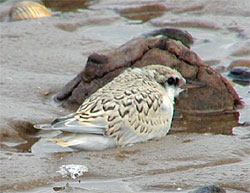 Anyway, here at Gronant the weather was appalling
in 2007
after a reasonable start at the end of May. Strong westerly winds covered the
nests with sand (despite the use of shelters) and rain soaked and chilled the
chicks. At one time we thought we would be lucky to get 50 young fledged so it
was with great delight when we found that the total at the end of the season was
99. A tribute to the persistence of the Little Terns and the
dedication of the wardening team.
Anyway, here at Gronant the weather was appalling
in 2007
after a reasonable start at the end of May. Strong westerly winds covered the
nests with sand (despite the use of shelters) and rain soaked and chilled the
chicks. At one time we thought we would be lucky to get 50 young fledged so it
was with great delight when we found that the total at the end of the season was
99. A tribute to the persistence of the Little Terns and the
dedication of the wardening team.
One thing that is clear from the graph is the upward trend for both numbers of pairs and young produced. The Gronant colony is one of the few in the country which shows such an increase with numbers elsewhere steadily decreasing. Undoubtedly if the RSPB hadn't started wardening in 1975 there wouldn't now be any Little Terns breeding at Gronant, and it is particularly pleasing that Denbighshire Countryside Services have continued the success since taking over in 2005.
So what can we expect in 2008? The weather during the last week in May and first week in June when nesting first starts is crucial. In my experience when we get good weather at this time the number of pairs breeding will be high - and once they start nesting they will stick around even if the weather subsequently deteriorates. I'm very hopeful that if we get reasonable weather then we will have another productive season.
I hope I've made it clear how much the colony relies on voluntary wardening to keep going, 2008 will be my ninth year and I always thoroughly enjoy it. As well as keeping an eye on the Little Terns there is always plenty of other birds around - I always look forward to the build up of Sandwich terns from late June onwards, and there are always plenty of birds out to sea - Common Scoters, Gannets, Arctic Skua, Manx Shearwaters and Gannets. The first task for which we need volunteers is putting up the fence, scheduled for May 7th and 8th, wardening last year started on May 21st so expect much the same date this year.
If you are interested in wardening just come along and say hello and see what is involved, or contact Adrian Hibbert by email (adrian.hibbert@denbighshire.gov.uk) or telephone 01745 356197. I should add that as well as the voluntary wardens there is always a contract warden on duty. It is their responsibility to organise the volunteers, make sure the electric fence is working and numerous other tasks. They do a splendid job and work very long hours, often arriving at the colony before dawn at 3.30am to make sure they get there before the crows!
Richard Smith
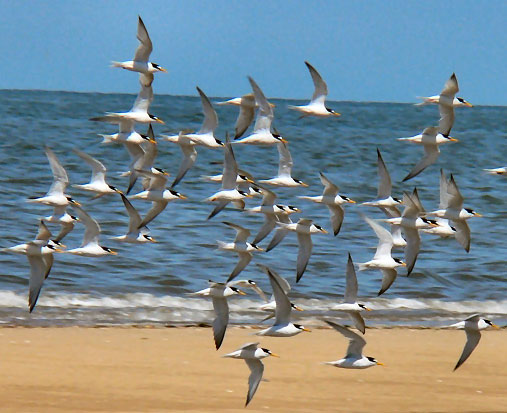
Sources of Information:
1. Karen Rippin, Owen Chamberlain and Philip ORourke,
Little Tern Report Gronant 2007, Denbighshire County Council Countryside
Services.
2. James Armstrong and Shane Hughes, Little Tern Colony Report 2005,
Denbighshire County Council Countryside Services.
3. Surbirds Archived Bird News, September 13 2007,
http://www.surfbirds.com/sbirdsnews/archives/2007/09/
4. Graph based on the original given to me by Gareth Stamp (RSPB) in 2001, and
subsequently updated by myself.
5. Status of Little Tern, JNCC,
http://www.jncc.gov.uk/pdf/UKSPA/UKSPA-A6-92.pdf.
April Bird News
The cold northerly winds which we endured in March continued well into April somewhat slowing the migration. However, southerlies mid-month came to our rescue bringing warmer weather and plenty of birds. Three White Storks overflying Neston on the 23rd were no doubt the birds of the month, three were seen flying over the Orkneys a few days later - perhaps the same birds? Other rarities included a Great Grey Shrike and male Black Redstart both at Red Rocks, a Spoonbill off Leasowe Lighthouse which spent several days at the Seaforth reserve across the Mersey, two Corn Bunting and a Cattle Egret on the Hoylake Langfields and a Great Northern Diver off Hilbre. The Cetti's Warbler at Neston Old Quay was seen or heard several times through the month.
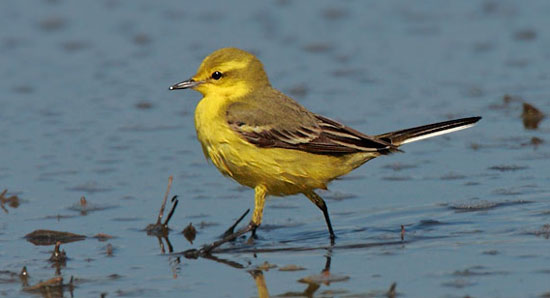
© Steve Round.
Five Yellow Wagtails at Leasowe Lighthouse on the 27th was the highest count for this species. Other max counts were 40 Wheatears on the 17th and 26th at Thurstaston and Leasowe Lighthouse respectively, 23 White Wagtail were on West Kirby beach on 23rd with 25 on nearby Hoylake Beach two days later, 6 Whinchat were by Leasowe Lighthouse on 30th.
| Species | 2008 | Location (08) | 2007 | 2006 |
|---|---|---|---|---|
| White Wagtail | 9th March | Leasowe | 13th March | 19th March |
| Wheatear | 13th March | Denhall Quay | 12th March | 23rd March |
| Swallow | 15th March | Hilbre | 16th March | 25th March |
| Sand Martin | 16th March | Inner Marsh Farm | 15th March | 26th March |
| Willow Warbler | 31st March | West Kirby | 3rd April | 31st March |
| House Martin | 11th April | West Kirby | 1st April | 29th March |
| Whitethroat | 11th April | Heswall | 15th April | 17th April |
| Swift | 22nd April | Leasowe | 16th April | 16th April |
| Cuckoo | 23rd April | Inner Marsh Farm | 15th April | 29th April |
Other notable migrants included eight Marsh Harriers (some reports may have been of the same bird), six Ospreys and six Ring Ouzels. Single Hobbys were seen at Inner Marsh Farm and Leasowe Lighthouse.
Out to sea a max of 5,500 Common Scoter were off North Wirral early in the month, a record high for Wirral. This is part of the huge 50-70,000 flock wintering in Liverpool Bay but they are normally further north or west, or way out to sea. 165 Little Gulls past Hilbre on 2nd was the highest count of the spring. An Arctic Skua was off Hilbre on 20th. 35 Purple Sandpiper was a good count for Hilbre on 6th and a remarkable 119 Brent Geese were still in the estuary on the same date.
Plenty of Whimbrel passed through, the max count being 25 on the breakwater near Leasowe Lighthouse on 23rd. One Whimbrel landed in someone's back garden in Stanley Road, Hoylake! 18 Avocet at Inner Marsh Farm on 23rd was a great sight, max counts of Black-tailed Godwits and Spotted Redshank here were 860 and 12 respectively.
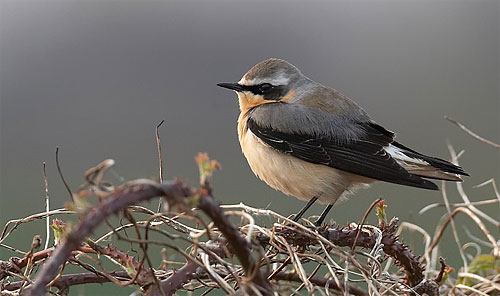
Inner Marsh Farm
Many of you will already have read in the RSPB
Birds magazine and in the local press about the exciting developments at Inner
Marsh Farm RSPB. The RSPB have purchased Burton Mere Fishery and also land to
the south-east of the reserve, more than doubling it's size. Burton Mere
Fishery is on the far side of the reserve from the hide and consists of some
large ponds and mature woodland. The
proposed further devolvement of the reserve, including improved visitor
facilities, is subject to planning permission so we
will have to wait for this before further details are available. In the mean
time the current restrictions apply - RSPB members only and the reserve is
closed on Tuesdays.
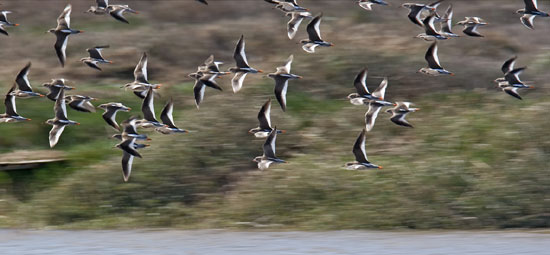
What to expect in May
Migration will continue well into May, both out
on the estuary and on land. 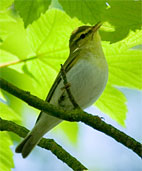 Early May is often a good time to see and hear Wood
Warblers like this one photographed in Stapledon Wood, Caldy, in April 2007 by Steve
Williams.
Early May is often a good time to see and hear Wood
Warblers like this one photographed in Stapledon Wood, Caldy, in April 2007 by Steve
Williams.
Any waders passing through will be in a hurry to get
north, these will include Dunlin, Sanderling and Ringed Plover, and the
occasional large flocks of Knot. Rarer waders might well include Wood Sandpiper,
Pectoral Sandpiper, Curlew Sandpiper and Spotted Redshank, the latter looking
great in their dark summer plumage. Best place to see these is Inner Marsh Farm, and hopefully we will have two or three pairs of Avocets breeding there
this spring. Also at IMF will be over summering immature Black-tailed Godwits,
most years we have several hundred, and sometimes Knot as well.
Ospreys and Marsh Harriers will continue to pass through, whilst Hobbys will take up their territories, there is usually a pair or two around our region.
Nesting at both our Common Tern colony at Shotton and the Little Tern colony at Gronant should be well under way by the end of the month. Out to sea look out for Gannets, Arctic Skuas and Manx Shearwaters.
Forthcoming Events
May Highest Spring Tides (Liverpool)
Also see
Tides page.
5th May, 11.46hrs (BST), 9.8m.
6th May, 12.33hrs (BST), 9.9m.
Forthcoming Events
Organised by the
Wirral Ranger Service ,
Flintshire Countryside Service and/or the RSPB:
All these events and walks have bird interest, even those not advertised
specifically for birdwatching. No need to book for these events unless
specified - please check below.
Sunday 4th May, 4.30am 6.30am, Dawn Chorus on the Dales.
Experience this magical time of day with the Rangers and members of Wirral
Wildlife and listen to the birdsong on the heathland as the sun rises over
the Heswall Dales Local Nature Reserve
and the Cleaver Heath Local Nature Reserve. This event is suitable for all
then family to enjoy. Sorry no dogs.
Booking essential, ring 0151 648 4371/3884 or
book on-line.
Sunday 4th May, 6am 8am, Catching the Warbler Wave.
The hedgerows and meadows at Wirral Country
Park are buzzing with warblers busy with nests and young during the
summer. Join the Rangers for a guided walk to search for and learn more
about these amazing sub-Saharan migrants. Please bring binoculars if you
have them. Sorry no dogs.
Booking essential, ring 0151 648 4371/3884 or
book on-line.
Sunday 4th May, 10am 12pm, Talacre Warren
Spring Walk (Point of Ayr).
Join the Ranger on a walk through the Warren and discover what spring is
like in the dunes. Booking essential: Wepre Park - 01244 814931. Meeting
point: Smugglers Inn car park, Talacre (SJ125848). Free.
Saturday 10th May, 1.30pm 3pm, Those Wonderful Trees.
Explore the woodland of Royden Park and
learn more about its history, management and folklore. This event is
suitable for all the family to enjoy. No need to book. Meet at the Walled
Garden, next to the Rangers Office, Royden Park, Frankby (CH48 1NP).
For further enquiries ring 0151 677 7594
Thursday 15th May, 10.30am 4pm, Working Wildlife Photography.
Local wildlife photographer Ron Thomas (ARPS) is running this practical
one-day course on photographing the natural world. Based in the lecture
theatre at Wirral Country Park and including field sessions in various
habitats, this down to earth course will appeal to beginners and keen
amateurs alike. There is a £10 charge per person for this event. Sorry no
dogs.
Booking essential, 0151 648 4371/3884 or
book on-line.
Thursday 22nd May, 6pm 9.30pm, Sunset Walk to
Hilbre.
Join the Ranger and cross the sands to discover the wildlife and history
of the Hilbre Islands Local Nature Reserve. This 4-mile walk of 4 hours is
ideal for first time visitors and suitable for all the family to enjoy,
although some people may find the walk strenuous in places. Warm
waterproof clothing and suitable footwear are essential. (Wellies are
recommended). Sorry no dogs. There is a £1 charge per person for this
event.
Booking essential, 0151 648 4371/3884 or
book on-line.
Saturday 24th May, 2pm Start, The Hilbre
Islands Local Nature Reserve
Learn about the history, wildlife and management of these tidal islands at
the mouth of the Dee Estuary at an afternoon illustrated talk at Wirral
Country Park by Alan Burton, Chair of the Friends of Hilbre.
Booking essential, 0151 648 4371/3884 or
book on-line.
Sunday 25th May, 10am 12.30pm, Uphill Down Dale.
Join the Ranger for an energetic circular hike from
Heswall Dales Local Nature Reserve along
the shoreline of the River Dee to Wirral Country Park and through the
Dungeon Woodland. This event is suitable for all the family to enjoy but
some parts of the walk are over steep gradients and difficult terrain.
Booking essential, 0151 648 4371/3884 or
book on-line.
Thursday 5th June, 6pm 9.30pm, Sunset Walk to
Hilbre.
Join the Ranger and cross the sands to discover the wildlife and history
of the Hilbre Islands Local Nature Reserve. This 4-mile walk of 4 hours is
ideal for first time visitors and suitable for all the family to enjoy,
although some people may find the walk strenuous in places. Warm
waterproof clothing and suitable footwear are essential. (Wellies are
recommended). Sorry no dogs. There is a £1 charge per person for this
event.
Booking essential, 0151 648 4371/3884 or
book on-line.
Saturday 7th June, 2pm Start, The Last 30 Years.
Senior Ranger James Locke invites you along to the Visitor Centre at
Wirral Country Park for a fascinating
illustrated talk on the first designated Country Park in England.
Booking essential, 0151 648 4371/3884 or
book on-line.
|
 |
The blank (UK) Birding Webring is a collection of quality birding web sites that are based in the United Kingdom. Visit the webring homepage for more information, or A complete list of all the sites in the webring is available by clicking here. previous site in ring : random site in ring : next site in ring |